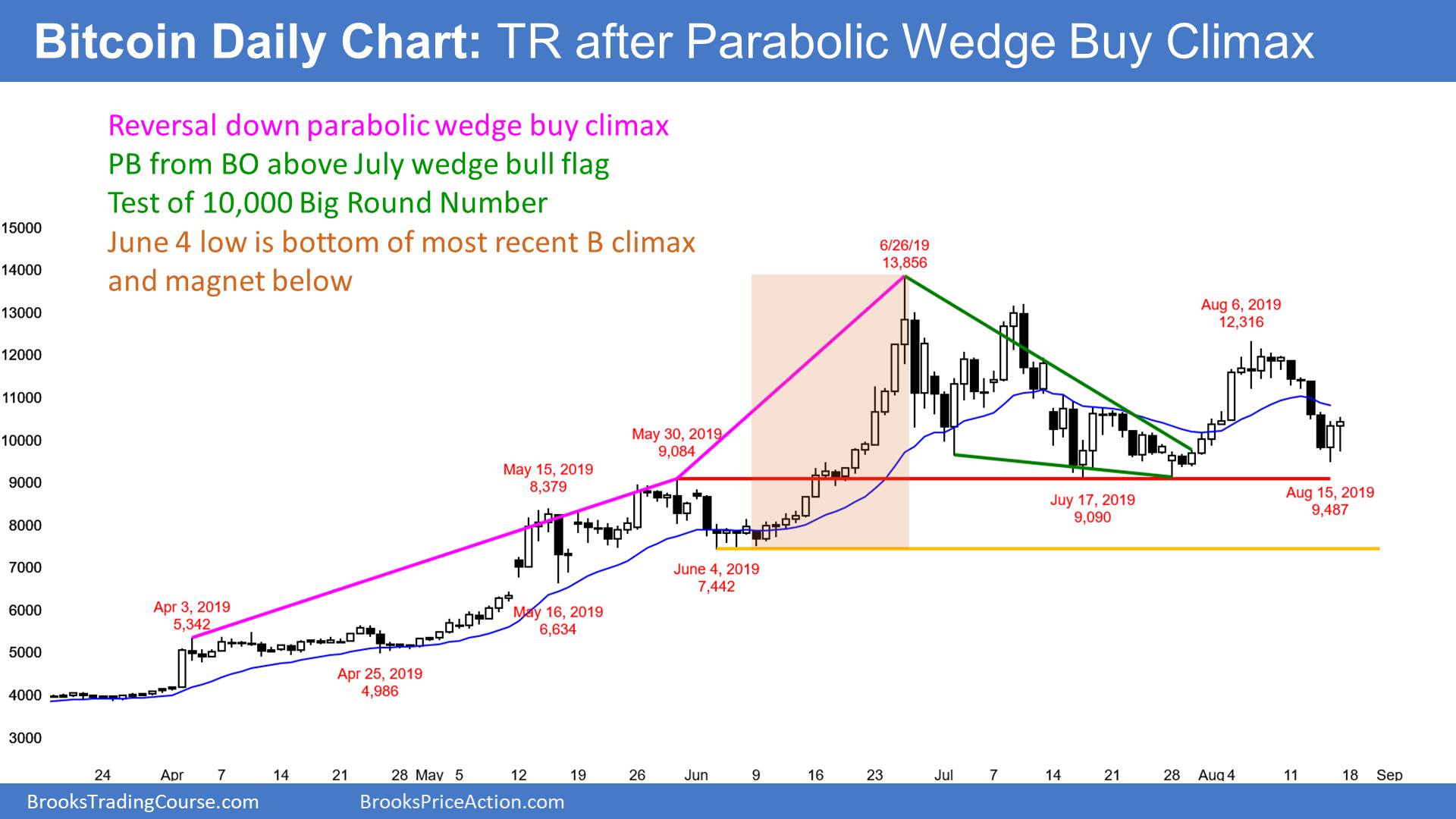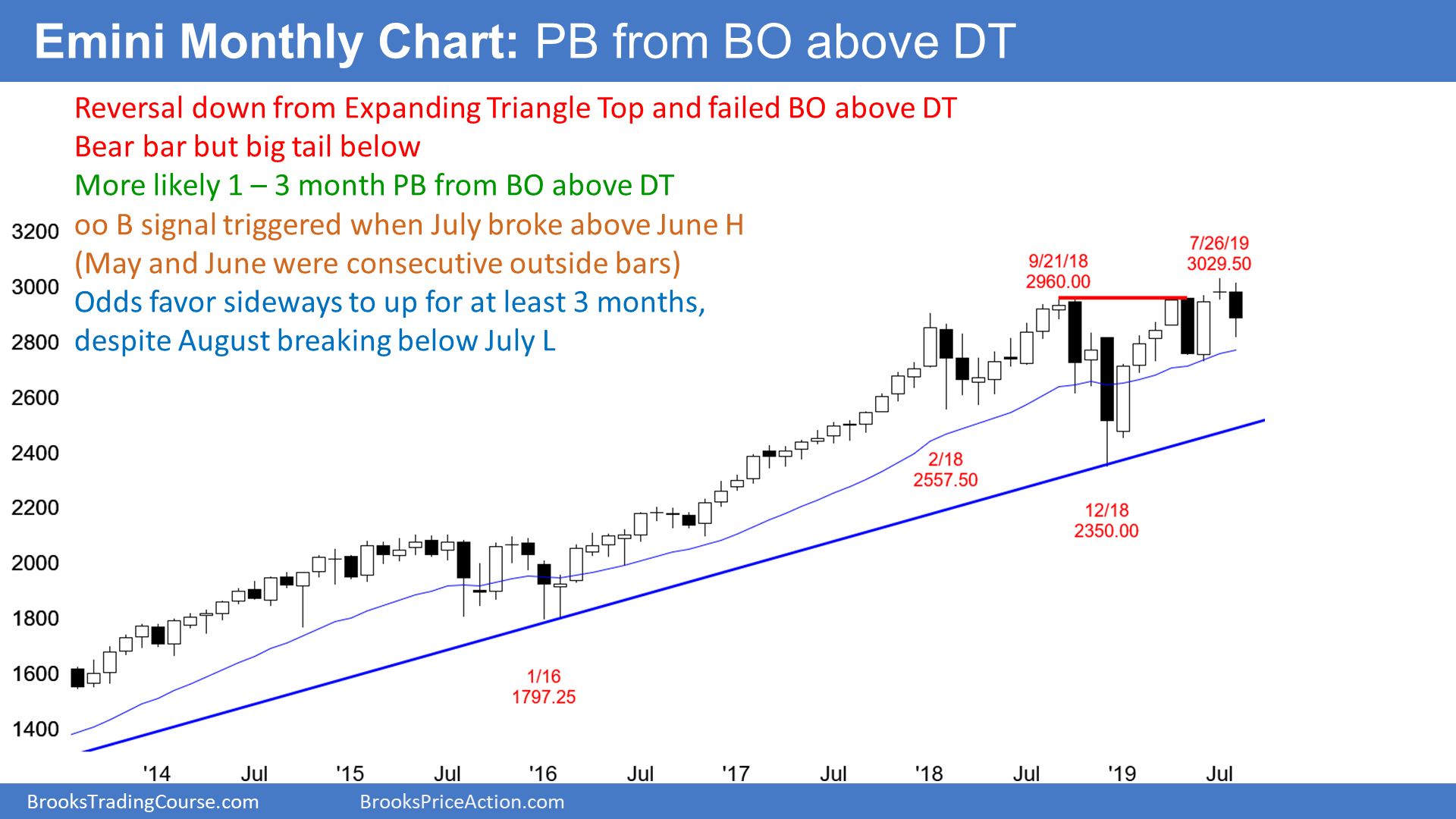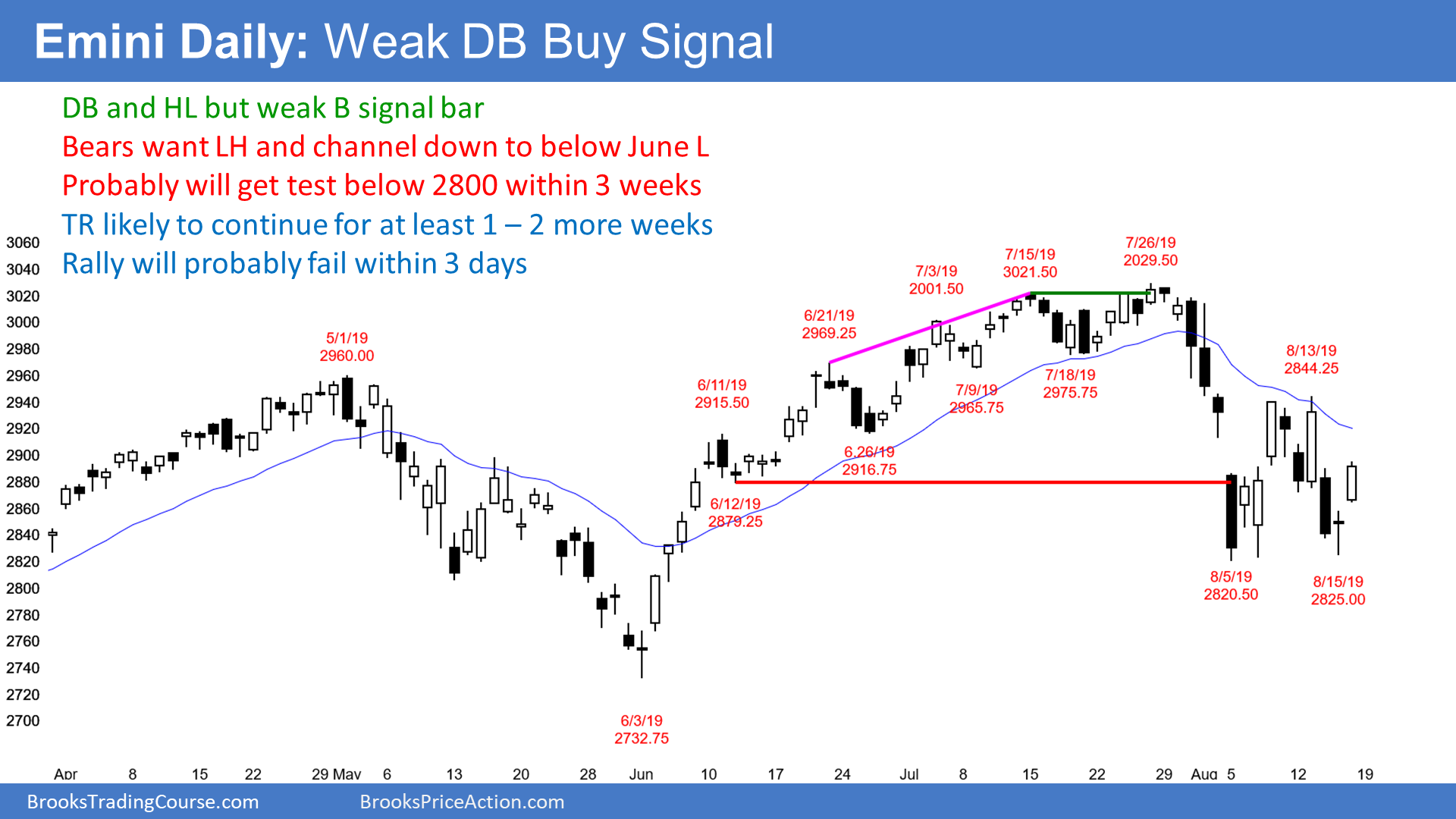Market Overview: Weekend Market Update
The Emini has been sideways for a couple of weeks, but it will probably fall below 2800 before the bulls will buy again. It might test the June low, which is the bottom of a 5-month trading range.
The 30 year treasury bond futures are in a strong breakout to a new all-time high. The bulls will probably soon begin to take some profits, which will lead to at least a 2 week pullback.
Bitcoin is trying to hold above 10,000, but there is a 50% chance that it will fully retrace the June/July buy climax and test 7500.
30 year Treasury Bond Futures market:
Parabolic wedge buy climax but no top yet

The 30 year Treasury Bond futures market rallied to a new all-time high this week. There was a nested wedge top from 2008 to 2016 on the monthly chart. That was a reliable trend reversal pattern.
When there is a credible top, there is a 40% chance of one more new high and then a 2nd top. If the bears get their 2nd top, it would have a higher probability of leading to a trend reversal on the monthly chart.
Trends on the monthly bond chart last 20 – 30 years. Therefore, if there is a reversal down, interest rates will work higher until around 2040.
No sign of a top, despite buy climax
It is important to accept that there is currently no top on the monthly chart. The rally is very strong. A strong rally typically does not instantly reverse into a bear trend.
Traders usually have to see the rally stop for a few months before the bears can get a reversal. The topping process might take 10 – 20 bars, which means 1 – 2 years. Therefore the downside risk near-term is small. Traders will buy the 1st reversal down.
The daily chart is in a parabolic wedge buy climax. It is testing the 2016 all-time high. The bulls who bought at that high can now exit breakeven. Many will.
Also, a huge buy climax will attract profit takers. The bulls have huge profits and soon will only want to buy pullbacks instead of that market. Their protective stop is far below. Soon, many will begin to take profits to reduce the risk of watching their windfall profits evaporate.
Their profit taking will probably result in 2 – 3 weeks of sideways to down trading. They will want to see if the bears can get a reversal down. If they cannot, the bulls will then buy again.
Negative interest rates
Many major countries now have negative interest rates. If you pay $100 for one of their bonds or notes, you to not have to pay them interest.
For example, if you buy a 10 year German bund (their equivalent of a US treasury note) with a face value of $100, you might have to pay $105. It will pay no interest. At the end of 10 years, Germany will give you $100 to buy back the bund. Your money will be tied up for 10 years and you will lose $5. You effectively lost about 5%, which is why the bund is said to have a negative interest rate.
Why would anyone buy a bund and lose 5% over 10 years? Why not just put the money in a safe deposit box? An obvious point is that safe deposit boxes get robbed and banks go out of business. No one wants to put a substantial part of their net worth in something that has any risk. The 10 year bund is safer.
A perfect trade?
Well, why doesn’t Germany sell a trillion dollars in bunds, pay no interest, and take the money and buy US Treasuries that might pay 1.7%? Isn’t that a perfect carry trade? Perfect trades cannot exist.
If you think a trade is perfect, you are missing something. What is missing? Forex and interest rate fluctuation.
If Germany buys a trillion dollars in US treasuries, they have to convert Euros to dollars when the buy and then dollars to Euros when they sell. What happens if the dollar falls 20% against the Euro over the next 10 years? Germany would have collected 1.7% for 10 years, or 17%, but they would lose 20% 10 years from now in the currency exchange.
Alternatively, what happens if the US treasury note futures market has a huge reversal down over the next 10 years? Remember, it is probably going to form a top withing the next couple years. Germany will be locked into a 1.7% return at a time when interest rates might be 5% or more in 5 – 10 years. That is a bad investment.
If they need more money to run their government 5 years from now, they will have to pay 5% interest to sell their bunds. But they will only be collecting 1.7% on the trillion dollars they used to by treasuries. They would be losing 3.3%, or $33 billion dollars a year on their investment.
Bitcoin cash index:
Tight trading range at 50% pullback from 2018 crash

Bitcoin has rallied strongly from the December low. But it has been in a tight trading range for 8 weeks at a 50% retracement of the 2018 crash. The bars on the weekly chart (not show) have been big and most have prominent tails. Also, there have been many reversals. There is no sign of an impending breakout up or down.
Because of the 8 month rally, TV only interviews the bulls. The least bullish expect a test of the 20,000 all-time high. The most bullish talk about a rally to 200,000 within two years.
Since Bitcoin is a market, it behaves like all other markets. Trading is ruled by logic and self-interest. There are enough buyers and sellers to create reliable patterns. Since Bitcoin is unregulated and there are still some big thieves out there, the swings can be big. But its chart looks no different from that of any other market.
8 week tight trading range so Breakout Mode
Because of the tight trading range and big reversals, it is now in a limit order market. It is in Breakout Mode. Traders are buying 1 – 2 week selloffs and selling out on 1 – 2 week rallies. The bulls are trying to trying to hold it above 10,000. They see the 2 week selloff as a pullback from a breakout above a 6 week triangle on the daily chart.
However, there are many emotional bulls who are too eager to buy. Look at all the failed rally attempts in 2018. Those were all bull traps. CNBC kept putting on confident, professorial, purportedly rich bitcoin bulls who kept claiming that the bear trend ended. The audience believed that they guys made a fortune by truly understanding Bitcoin. If they say that Bitcoin was about to resume up, you have to trust them.
Bad idea. Profitable traders only trust themselves, not idiots on TV. The weak bulls kept buying and repeatedly got trapped by the absence of strong bulls willing to buy higher.
The same is true now. Traders should expect a lack of follow-through buying. In addition, it is better if traders trade small, use wide stops, and have the ability to scale in lower. That will give them the best chance of trading Bitcoin profitably.
Will 10,000 hold?
Will important psychological 10,000 Big Round Number hold? I suspect not. This week’s reversal up from below 10,000 is more likely just the start of another leg in the 8 week trading range than a resumption of the bull trend.
The parabolic rally in 2019 had 3 legs up. The first ended with the April 3 high and the 2nd ended with the May 30 high.
You can see that the 3rd leg up from the June 4 low was huge. A huge rally typically results in exhausted bulls. They take profits and then are not be too eager to buy again. There often has to be a bear breakout below the bottom of the final leg up before the bulls will believe that the pullback has ended. Consequently, anyone buying now has a better chance of making money trading small and using a wide stop. That June 4 low of 7442 is an important magnet below.
How low can Bitcoin go?
While the bulls are hoping that the pullback ended with this week’s test of 10,000, there is better than a 50% chance of a retracement of the entire 3rd leg up. That means a test of the June 4 of 7442. If 10,000 does not hold, that is the next target. At the moment, traders should expect it to get tested within a few months.
When there is a reversal down from a parabolic wedge, the bulls typically want to see a test of the bottom of the 1st or 2nd pullback. The 2nd pullback was the May 16 low of 6334. That was also a test of a gap above the May 10 high. That is the next support.
Finally, a much less likely target is the bottom of the 1st pullback in the wedge bull channel. That is the April 25 low of 4986.
Since Bitcoin has been sideways for 8 weeks, it might have another leg up before breaking below 10,000 and testing 7442. But unless the bulls beak far above the June high, Bitcoin will probably have to go lower to find buyers.
Monthly S&P500 Emini futures chart:
Expanding triangle top, but only minor reversal likely

The monthly S&P500 Emini futures chart so far has a big bear bar in August. I have been writing for several months that the weekly and monthly charts were likely to form an expanding triangle top. However, after the July broke above consecutive outside bars in May and June, there was only a 40% chance of a major trend reversal into a bear trend.
As strong as the August selloff has been, it is still only a one month pullback in a strong bull trend. Traders should expect that the pullback to end within a month or two. The Emini will then likely make a new high before there is a trend reversal into a bear trend.
What happens if the bears can create two or three big bear bars closing on their lows? The odds would then shift in favor of a test of the December low. At the moment, they only have a 30% chance of achieving their goal before there is a new high.
What about the inverted yield curve?
This week was the 1st time in 12 years when the interest rate of the 2 year treasury note was higher than that of the 10 year note. A note is a loan that you make to the government. A note for 10 years has 10 years of risk and uncertainty. You would expect that the government would have to pay more interest to entice buyers into taking that increased risk.
Why would investors be willing to earn so little when locking their money up for such a long time? It is because they have compared the 10 year note to other investments, like stocks and real estate, and decided that the low rate with the high security is their best choice. They clearly are not optimistic about the future. They are afraid that other investments will lose money.
An inverted yield curve is a buy signal!
An inverted yield curve is a reliable predictor of a recession. There have been 9 instances of a 2/10 year yield curve inversion since World War 2, and 7 led to a recession. Depending on how one defines a recession, some say that all 9 led to a recession.
But there is another statistic that usually gets overlooked. A yield curve inversion is a buy signal! Stocks rallied 15% on average 18 months after the inversion. The average time before a recession is 22 months (range of 5 – 34 months). Therefore, traders have a window when they can make money.
What happens once the recession hits? Not good. At 36 months after the inversion, the stock market is up only 2% from the time of the inversion.
It is reasonable to assume at this point that this inversion is similar to the others. If so, traders should expect a 15% rally over the next 18 months. But they should also expect the stock market to lose most of those gains over the next 18 months and be up only 2% from today’s level.
The yield curve inverted yesterday and the S&P cash index closed the day at 2841. That means that in August 2022, the S&P might only be at 2898, even though it could rally to 3267 in February 2021.
Weekly S&P500 Emini futures chart:
Failed buy signal, as expected

The weekly S&P500 Emini futures chart has been in a trading range from 2750 to 2930 for 5 months. That range is in the top half of 20 month trading range from 2350 to 2930. There is no sign of an impending breakout.
There was a big bull reversal bar 2 weeks ago. It was a High 1 buy flag and a buy signal bar for this week. Since it was a good looking buy signal bar in a bull trend, I said that the Emini would probably go above its high this week to trigger the buy signal. And it did.
However, I also said that there would probably be more sellers than buyers above its high. Why would traders sell above a good looking buy signal bar? Because it was not as good as it looked. Context, which means the bars to the left, is important.
Bad buy setup despite good looking buy signal bar
I pointed out that it followed a huge bear bar and a buy climax. After that bear bar and the buy climax, the odds were that the weekly chart would be sideways to down for at least a couple more weeks. That meant that the buy signal would fail.
In addition, the bar had a prominent tail on top. That further lowered the probability for the bulls.
Also, it was a big bar. If a trader bought above its high and put a stop below its low, he would have a big risk. Since a lower high was likely, the reward was small.
It was a buy signal bar with bad risk/reward and low probability for stop entry bulls buying above its high. Since there is nothing in it for the bulls, there would probably be more bears selling with limit orders at the top of the buy signal bar. And there were.
While this week was the entry bar, it was a doji and therefore weak. The weekly chart will probably trade sideways to down for at least another couple weeks.
Daily S&P500 Emini futures chart:
Double top with double bottom means trading range

The daily S&P500 Emini futures chart formed a micro double bottom on August 5th and 7th. Thursday’s low was a test of last week’s low and there is now a double bottom. There is also a micro double top just below the EMA. When a chart has both credible buy and sell signals, it is in a trading range.
The Big Up in June and July and now the Big Down in August has created Big Confusion. When there is confusion, traders bet against sustained moves up or down.
Traders are uncertain of the direction of the breakout. They expect reversals instead of a trend up or down. Traders buy strong selloffs, sell strong rallies, and take quick profits, betting against sustained moves. This creates a trading range.
The June/July rally was a typical Spike and Channel pattern, which I have discussed often. During the July bull channel, I said many times that there would be a break below the bull channel, a test of the June 12 start of the bull channel, and then a trading range. The market is behaving as was likely, although the bars and legs have been bigger than what was likely.
Traders are now deciding if the 2 week selloff is a 50% pullback from the June/July rally or the start of a trend down to below the June low.
Both outcomes can happen. The selloff is strong enough so that traders should expect it to continue down to at least a little below the August 5 low and 2800. But it might not be strong enough to fall below the June low of 2732.75.
Over the next week, traders will continue to look for reversals every few days. But the odds favor a test below 2800 within a couple weeks.
